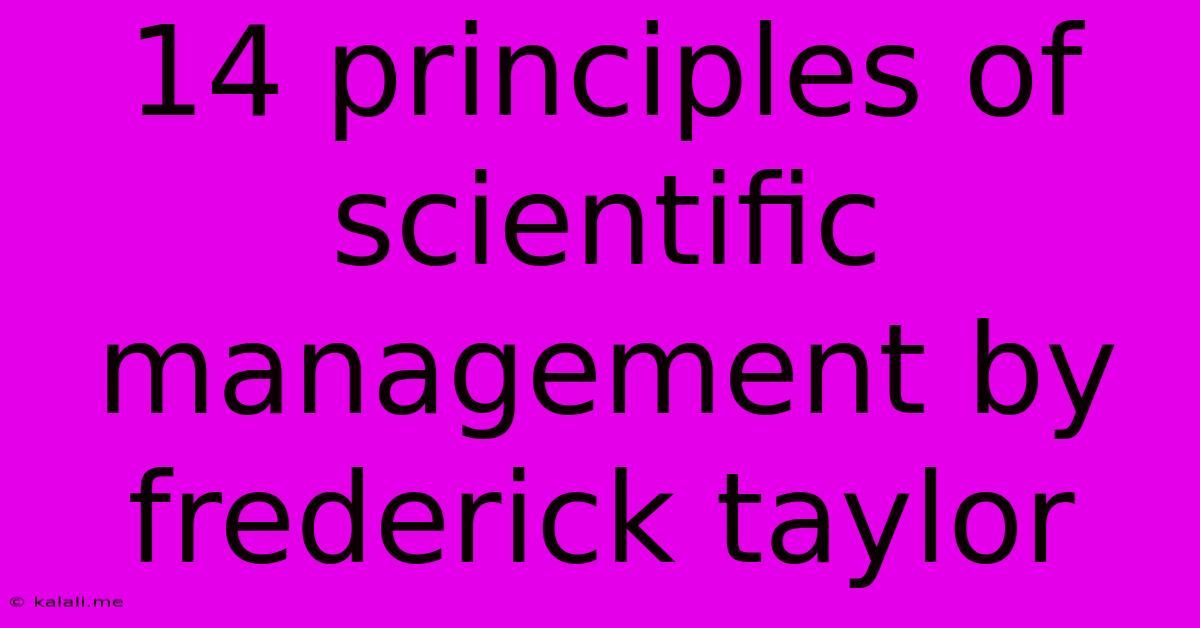14 Principles Of Scientific Management By Frederick Taylor
Kalali
Jun 14, 2025 · 4 min read

Table of Contents
14 Principles of Scientific Management: Optimizing Efficiency and Productivity
Frederick Winslow Taylor's Scientific Management, also known as Taylorism, revolutionized industrial processes in the early 20th century. His approach, focused on increasing efficiency and productivity, was built upon a set of 14 principles. Understanding these principles remains crucial for modern businesses seeking to optimize their operations and achieve a competitive edge. This article delves into each principle, explaining its significance and practical applications.
Meta Description: Explore Frederick Taylor's 14 principles of scientific management – a foundational theory for improving industrial efficiency and productivity. Learn how these principles remain relevant for modern business optimization.
1. Science, Not Rule of Thumb:
This core principle advocates replacing traditional methods based on guesswork and personal experience with scientifically-developed standardized processes. Through observation, measurement, and analysis, optimal work methods can be determined, leading to significant improvements in efficiency. This involves careful study of tasks, tools, and workflows to identify the most efficient approaches.
2. Harmony, Not Discord:
Taylor emphasized the importance of collaboration between management and workers. Instead of conflict, a spirit of cooperation should prevail, fostering a shared understanding of goals and a commitment to achieving them. Open communication and mutual respect are essential for implementing this principle.
3. Cooperation, Not Individualism:
This principle emphasizes teamwork and collaboration, replacing individual efforts with coordinated group activities. By working together and supporting each other, teams can achieve higher levels of productivity and efficiency than individuals working in isolation. Effective team management and clear communication are crucial.
4. Maximum Output, Not Restricted Output:
Taylor believed that maximizing output benefits both the company and the worker. This involved identifying and eliminating bottlenecks and inefficiencies, leading to higher production levels and potentially higher wages for workers. This requires careful planning and resource allocation.
5. Development of Each and Every Person to His or Her Greatest Efficiency and Prosperity:
This principle highlights the importance of employee development and training. By providing employees with the skills and knowledge they need to perform their jobs effectively, organizations can increase productivity and improve employee satisfaction. This involves investing in training programs and promoting continuous learning.
6. Scientific Selection and Training of the Worker:
Matching the right worker to the right job is critical. Scientific selection involves identifying individuals with the appropriate skills and aptitudes for specific tasks. Training programs then equip these individuals with the necessary skills to perform their jobs efficiently and effectively.
7. Division of Work:
Taylor advocated for a clear division of labor between managers and workers. Managers plan and supervise, while workers execute the tasks. This separation of responsibilities promotes specialization and efficiency. Clear roles and responsibilities are essential for successful implementation.
8. Equal Division of Work and Responsibility Between Management and Workers:
While responsibilities are divided, this principle suggests a shared responsibility for success. Management plans and provides resources, while workers execute efficiently. Both are equally vital for optimal performance. This fosters collaboration and shared accountability.
9. Standardization of Tools and Work Conditions:
Using standardized tools and maintaining consistent work conditions minimizes variations and maximizes efficiency. This ensures that workers have the right equipment and environment to perform their tasks effectively. Consistency and standardization reduce errors and improve quality.
10. Scientifically Planned Tasks:
Tasks should be meticulously planned and designed to optimize efficiency. This involves breaking down complex tasks into smaller, manageable steps, each with clear instructions and procedures. Efficient task design reduces wasted time and effort.
11. Financial Incentives:
Taylor recognized the motivating power of financial incentives. By rewarding workers for increased productivity, organizations can encourage higher performance and greater efficiency. This requires careful design of compensation structures that align with performance goals.
12. Time and Motion Studies:
This crucial component involves analyzing work processes to identify and eliminate unnecessary movements and wasted time. Time and motion studies provide data-driven insights for optimizing workflows and improving efficiency. This is a foundational aspect of Taylorism.
13. Functional Foremanship:
This involves assigning multiple supervisors to oversee different aspects of a worker's performance. This provides specialized guidance and support, improving efficiency and addressing specific issues effectively. While complex, it can improve supervision and training.
14. Fatigue Studies:
Understanding and mitigating worker fatigue is crucial for maintaining productivity. Fatigue studies help identify factors that contribute to fatigue and develop strategies to minimize their impact. This promotes worker well-being and sustained productivity.
Conclusion:
Frederick Taylor's 14 principles of scientific management, while developed over a century ago, remain highly relevant in today's business environment. By applying these principles, organizations can optimize their operations, improve productivity, and achieve a competitive edge. While some aspects of Taylorism have been criticized for their potential to dehumanize work, a careful and balanced application of these principles, with an emphasis on worker well-being and collaboration, can significantly enhance organizational efficiency and success.
Latest Posts
Latest Posts
-
Which Plant Organelle Is Responsible For Photosynthesis
Jun 15, 2025
-
What Element Family Does Potassium Belong To
Jun 15, 2025
-
Lcm Of 5 10 And 15
Jun 15, 2025
-
How To Write 175 On A Check
Jun 15, 2025
-
Conductor Atoms Normally Have Answer Valence Electrons
Jun 15, 2025
Related Post
Thank you for visiting our website which covers about 14 Principles Of Scientific Management By Frederick Taylor . We hope the information provided has been useful to you. Feel free to contact us if you have any questions or need further assistance. See you next time and don't miss to bookmark.